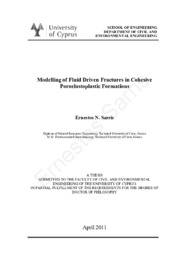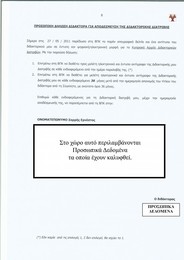| dc.contributor.advisor | Papanastasiou, Panos | en |
| dc.contributor.author | Sarris, Ernestos N. | en |
| dc.coverage.spatial | Cyprus | en |
| dc.creator | Sarris, Ernestos N. | en |
| dc.date.accessioned | 2012-10-04T08:24:33Z | |
| dc.date.accessioned | 2017-08-01T07:41:56Z | |
| dc.date.available | 2012-10-04T08:24:33Z | |
| dc.date.available | 2017-08-01T07:41:56Z | |
| dc.date.issued | 2011-05 | |
| dc.date.submitted | 2011-05-27 | |
| dc.identifier.uri | https://gnosis.library.ucy.ac.cy/handle/7/39015 | en |
| dc.description | Includes bibliography (p. 229-241). | en |
| dc.description | Number of sources in the bibliography: 156 | en |
| dc.description | Thesis (Ph. D.) -- University of Cyprus, Faculty of Engineering, Department of Civil and Environmental Engineering, May 2011. | en |
| dc.description | The University of Cyprus Library holds the printed form of the thesis. | en |
| dc.description.abstract | Το πρόβλημα της υδραυλικής ρωγμής συναντάται στη τεχνική της υδραυλικής θραύσης, που εφαρμόζεται από την πετρελαϊκή βιομηχανία για την αύξηση της ανάκτησης υδρογονανθράκων. Κατά την εφαρμογή της τεχνικής, προσοχή δίδεται στην πρόβλεψη της πίεσης στη γεώτρηση που μετρείται κατά την διεξαγωγή και είναι η μοναδική διαθέσιμη παράμετρος για την αξιολόγησή της. Ο κύριος στόχος αυτής της έρευνας είναι η διερεύνηση των ασυμφωνιών, μεταξύ των προσομοιωτών, που συνήθως υποεκτιμούν την πρόβλεψη της πίεσης στη γεώτρηση και των παρατηρήσεων στο πεδίο. Με αυτό το κίνητρο, δημιουργήθηκε ένα προσομοίωμα υδραυλικής ρωγμής, το οποίο επιλύθηκε με τη μέθοδο των πεπερασμένων στοιχείων.
Αυτή η ερευνητική εργασία πραγματοποιήθηκε με την προσέγγιση της συνεκτικής ζώνης για υδραυλικές ρωγμές, που διαδίδονται σε αδιαπέρατους και πλήρως διαπερατούς σχηματισμούς. Από την ανάλυση που πραγματοποιήθηκε, φαίνεται ότι το πλάτος της ρωγμής είναι μεγαλύτερο και η πίεση που απαιτείται για τη διάδοση της είναι υψηλότερη, όταν ο καταστατικός νόμος που περιγράφει τη θραύση είναι ελαστικός σε σύγκριση με τη περίπτωση που είναι άκαμπτος και για τις δυο περιπτώσεις, αδιαπέρατου και πλήρως διαπερατού σχηματισμού. Βρέθηκε ότι το μέγεθος της συνεκτικής ζώνης, η γεωμετρία της ρωγμής και η πίεση διάδοσης αυξάνονται με την αύξηση του επιτόπου εντατικού πεδίου.
Βρέθηκε επίσης, ότι υψηλότερη πίεση χρειάζεται για τη διάδοση της υδραυλικής ρωγμής σε ποροελαστικό σχηματισμό, όπου το πλάτος της ρωγμής είναι μεγαλύτερο. Επιπρόσθετα, όταν ο ρυθμός εισπίεσης στη γεώτρηση είναι μεγαλύτερος, τότε δημιουργούνται μεγαλύτερα πλάτη ρωγμών και υψηλότερες πιέσεις διάδοσης. Επί πλέον, όταν ο σχηματισμός έχει μεγάλη διαπερατότητα, τότε το πλάτος της ρωγμής που δημιουργείται είναι μεγαλύτερο.
Σε συνεκτικούς ποροελαστοπλαστικούς σχηματισμούς, προτείνουμε τη σχέση που προβλέπει το μέγεθος των πλαστικών ζωνών. Βρέθηκε, ότι το μέγεθος της συνεκτικής ζώνης που περιέχει και το μέγεθος της πλαστικής, αυξάνεται α) με τον ελαστικό καταστατικό νόμο θραύσης, β) με την αποκλίνουσα τάση, γ) με το ρυθμό εισπίεσης και δ) με την πίεση του σχηματισμού. Αντίστροφες τάσεις δημιουργούνται, οι οποίες τείνουν να μειώσουν το πλάτος, μειώνοντας έτσι τη γεωμετρία της ρωγμής. Από τη διερεύνηση αυτή, προτείνεται ένα μαθηματικό προσομοίωμα βασισμένο στις φυσικές διεργασίες που επικρατούν κατά τη διάδοση της υδραυλικής ρωγμής σε ποροελαστοπλαστικούς σχηματισμούς και το οποίο εξηγεί τις υψηλές πιέσεις που παρατηρούνται στο πεδίο. | el |
| dc.description.abstract | The fluid driven problem arises in hydraulic fracturing, a technique widely used in the petroleum industry to enhance the recovery of hydrocarbons. In practice, attention is focused on the prediction of wellbore pressure which is measured during the treatment and is the only parameter available to evaluate the operation. The main objective is to investigate the discrepancy between classical hydraulic fracturing simulators, which underestimate these pressures, and field observations. A model that governs the fluid driven fracture was build and solved numerically with the finite elements.
The research was performed with the cohesive zone approach for impermeable and permeable fluid driven fractures. It is demonstrated that the fracture profiles and the propagation pressures are larger in the case of elastic-softening cohesive model compared to the rigid-softening cohesive model for both elastic and poroelastic cohesive solids. It is found that the size of the process zone, the fracture geometry and the propagation pressure increase with increasing confining stresses.
We found that higher pressures are needed to extend a fracture in a poroelastic medium and the created profiles are wider. Furthermore, wider fracture profiles are obtained with higher injection rates and the fluid pressures and the fracture apertures are larger in the case of a high permeability formation.
In cohesive poroelastoplastic formations, a scaling law was proposed to predict the size of the plastic zones. We found that size of the process zone which includes plastic zone increase with a) the elastic-softening cohesive model b) with the stress deviator c) with the injection rate and d) formation pressure. Back stresses are created which tend to reduce the fracture width in the bulk of the fracture. We propose a mathematical model based on the dominant physical processes involved in a cohesive poroelastoplastic rock formation for explaining the elevated net pressures observed in field treatments. | en |
| dc.format.extent | xxii, 241 p. : charts, diagrs. (some col.) ; 30 cm. | en |
| dc.language.iso | eng | en |
| dc.publisher | Πανεπιστήμιο Κύπρου, Πολυτεχνική Σχολή / University of Cyprus, Faculty of Engineering | |
| dc.rights | info:eu-repo/semantics/openAccess | en |
| dc.rights | Open Access | en |
| dc.subject.lcsh | Environmental hydraulics | en |
| dc.subject.lcsh | Fluid dynamics | en |
| dc.subject.lcsh | Hydraulic engineering Research | en |
| dc.subject.lcsh | Elasticity | en |
| dc.subject.lcsh | Elastic analysis (Engineering) | en |
| dc.subject.lcsh | Porous materials Fluid dynamics | en |
| dc.subject.lcsh | Finite element method | en |
| dc.title | Modelling of fluid driven fractures in cohesive poroelastoplastic formations | en |
| dc.title.alternative | Μοντελοποίηση Υδραυλικών Ρωγμών σε Συνεκτικούς Ποροελαστοπλαστικούς Σχηματισμούς | el |
| dc.type | info:eu-repo/semantics/doctoralThesis | en |
| dc.contributor.committeemember | Παπαναστασίου, Πάνος | el |
| dc.contributor.committeemember | Παπαμίχος, Ευριπίδης | el |
| dc.contributor.committeemember | Χαρμπής, Δήμος | el |
| dc.contributor.committeemember | Λουκίδης, Δημήτριος | el |
| dc.contributor.committeemember | Sulem, Jean | en |
| dc.contributor.committeemember | Papanastasiou, Panos | en |
| dc.contributor.committeemember | Papamichos, Evripidis | en |
| dc.contributor.committeemember | Charmpis, Dimos | en |
| dc.contributor.committeemember | Loukides, Demetrios | en |
| dc.contributor.department | Τμήμα Πολιτικών Μηχανικών και Μηχανικών Περιβάλλοντος / Department of Civil and Environmental Engineering | |
| dc.subject.uncontrolledterm | ΥΔΡΑΥΛΙΚΗ ΘΡΑΥΣΗ | el |
| dc.subject.uncontrolledterm | ΠΕΠΕΡΑΣΜΕΝΑ ΣΤΟΙΧΕΙΑ | el |
| dc.subject.uncontrolledterm | ΣΥΝΕΚΤΙΚΗ ΖΩΝΗ | el |
| dc.subject.uncontrolledterm | ΘΡΑΥΣΤΟΜΗΧΑΝΙΚΗ | el |
| dc.subject.uncontrolledterm | ΠΟΡΟΕΛΑΣΤΙΚΟΤΗΤΑ | el |
| dc.subject.uncontrolledterm | ΡΟΗ ΣΕ ΠΟΡΩΔΗ ΥΛΙΚΑ | el |
| dc.subject.uncontrolledterm | ΣΥΖΕΥΞΗ ΡΟΗΣ-ΠΑΡΑΜΟΡΦΩΣΗΣ | el |
| dc.subject.uncontrolledterm | ΠΟΡΟΕΛΑΣΤΟΠΛΑΣΤΙΚΟΤΗΤΑ | el |
| dc.subject.uncontrolledterm | HYDRAULIC FRACTURING | en |
| dc.subject.uncontrolledterm | FINITE ELEMENTS | en |
| dc.subject.uncontrolledterm | COHESIVE ZONE | en |
| dc.subject.uncontrolledterm | FRACTURE MECHANICS | en |
| dc.subject.uncontrolledterm | POROELASTICITY | en |
| dc.subject.uncontrolledterm | POROELASTOPLASTICITY | en |
| dc.subject.uncontrolledterm | FLOW IN POROUS MEDIA | en |
| dc.subject.uncontrolledterm | COUPLED FLUID FLOW-DEFORMATION | en |
| dc.identifier.lc | TC163.5.S27 2011 | en |
| dc.author.faculty | Πολυτεχνική Σχολή / Faculty of Engineering | |
| dc.author.department | Τμήμα Πολιτικών Μηχανικών και Μηχανικών Περιβάλλοντος / Department of Civil and Environmental Engineering | |
| dc.type.uhtype | Doctoral Thesis | en |
| dc.rights.embargodate | 2014-05-27 | |
| dc.contributor.orcid | Papanastasiou, Panos C. [0000-0002-7506-221X] | |


